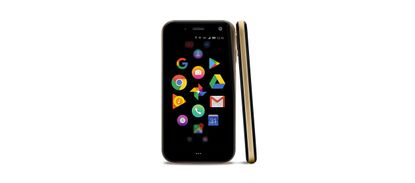In praise of the worst phone on the market
The crappy Palm phone is exactly what tech needs


It's fall, and in the tech world that means one thing: new stuff. From smartphones to computers to gadgets, new and improved devices are released this season by seemingly every manufacturer, boasting more specs, more speed, more everything.
That's what makes the new Palm phone so interesting. The newly announced device, sporting the name of the now defunct PDA maker, is a deliberately small, simple smartphone that is decidedly less. It has a tiny 3.3-inch screen; a very basic selection of apps like texting, maps, and a phone; a simple camera and ... that's it. Oh, and the Warriors' Stephen Curry is an investor and spokesperson. It's a companion phone, for when you want to leave the house without the constant distraction of your main device, but don't want to disconnect entirely.
Put another way, it's a bad phone, but on purpose. And indeed, the reaction has been just that: to call it bad. Most tech press so far has scoffed at the phone because of its inherent limitations, but also some genuinely poor choices, such as limiting it to Verizon and making it a secondary device, like a smartwatch, rather than a standalone phone.
Subscribe to The Week
Escape your echo chamber. Get the facts behind the news, plus analysis from multiple perspectives.

Sign up for The Week's Free Newsletters
From our morning news briefing to a weekly Good News Newsletter, get the best of The Week delivered directly to your inbox.
From our morning news briefing to a weekly Good News Newsletter, get the best of The Week delivered directly to your inbox.
But maybe the Palm phone is exactly what tech needs — which is to say, less. Rather than constantly focusing on what it can add, the way forward for tech is to find a sustainable business model predicated on taking things away.
Absence, however, isn't the only interesting thing about the Palm phone. The idea of a distraction-less secondary device has been a running theme for the past couple of years. There are minimalist gadgets like the Light Phone, which let you only call or message. Then there are things like the Apple Watch, which now let you make calls or text while also tracking fitness.
The trouble with those devices, though, is that they lack something critical, like a keyboard to make texting actually viable or a camera to document the minutiae of your day. So the Palm phone's inclusion of both things, in addition to Google Maps and email, seems to strike a good balance: It gives you some of the benefits of a full smartphone, without all of its drawbacks — particularly the pull of social media.
That's not to say the criticisms of the device are completely unfair, though. The solution to tech overload is rarely more tech. And more practically, tying the Palm phone to one carrier while also forcing consumers to add it to an existing plan will likely limit its appeal significantly.
On an abstract level, there's also something about the idea of a bad phone that runs counter to everything we think we know about the tech industry. A new phone that promises fewer features and less capability? It's so vaguely "un-American" and anti-capitalist that it seems destined to fail not just on its merits, but almost on ideological grounds. "What do you mean you want to get something that is deliberately worse?" an ordinary consumer might ask.
More is tech's entire business model. How else do you entice consumers to upgrade their devices or try the newest app feature or service if not jamming ever more stuff into things? But as smartphones and computers have become central to both our personal and work lives, even tech makers themselves are noticing their deleterious effects. Apple and Google have both added features to help users limit their time on their smartphones. Facebook keeps talking about time well spent. Yet all these tech companies' financial models depend on you buying more things or spending more time on their platforms. It's a miasma of conflicting interests.
Where we end up is a product like the Palm phone: an interesting anomaly in the tech landscape, likely doomed to be unsuccessful, all the while meeting a need that no one else is. Meanwhile, there's increasing evidence supporting the case for less tech. As but one example, boredom appears to be good for creativity — that is, simply not doing something can actually be better than doing anything at all.
It's precisely that counterintuitive inversion that tech needs more of. From design principles in software, to how hardware gets updated and created, tech needs to respond to its effects on the world by embracing limitation, constraint — even frustration.
The Palm phone is terrible. Isn't that great?
Create an account with the same email registered to your subscription to unlock access.
Sign up for Today's Best Articles in your inbox
A free daily email with the biggest news stories of the day – and the best features from TheWeek.com
Navneet Alang is a technology and culture writer based out of Toronto. His work has appeared in The Atlantic, New Republic, Globe and Mail, and Hazlitt.
-
 Cicada-geddon: the fungus that controls insects like 'zombies'
Cicada-geddon: the fungus that controls insects like 'zombies'Under The Radar Expert says bugs will develop 'hypersexualisation' despite their genitals falling off
By Chas Newkey-Burden, The Week UK Published
-
 'Voters know Biden and Trump all too well'
'Voters know Biden and Trump all too well'Instant Opinion Opinion, comment and editorials of the day
By Harold Maass, The Week US Published
-
 Is the Gaza war tearing US university campuses apart?
Is the Gaza war tearing US university campuses apart?Today's Big Question Protests at Columbia University, other institutions, pit free speech against student safety
By Joel Mathis, The Week US Published
-
 How do you solve a problem like Facebook?
How do you solve a problem like Facebook?The Explainer The social media giant is under intense scrutiny. But can it be reined in?
By Peter Weber Published
-
 Microsoft's big bid for Gen Z
Microsoft's big bid for Gen ZThe Explainer Why the software giant wants to buy TikTok
By Amrita Khalid Published
-
 Apple is about to start making laptops a lot more like phones
Apple is about to start making laptops a lot more like phonesThe Explainer A whole new era in the world of Mac
By Navneet Alang Published
-
Why are calendar apps so awful?
The Explainer Honestly it's a wonder we manage to schedule anything at all
By Navneet Alang Published
-
 Tesla's stock price has skyrocketed. Is there a catch?
Tesla's stock price has skyrocketed. Is there a catch?The Explainer The oddball story behind the electric car company's rapid turnaround
By Jeff Spross Published
-
 How robocalls became America's most prevalent crime
How robocalls became America's most prevalent crimeThe Explainer Today, half of all phone calls are automated scams. Here's everything you need to know.
By The Week Staff Published
-
 Google's uncertain future
Google's uncertain futureThe Explainer As Larry Page and Sergey Brin officially step down, the company is at a crossroads
By Navneet Alang Published
-
 Can Apple make VR mainstream?
Can Apple make VR mainstream?The Explainer What to think of the company's foray into augmented reality
By Navneet Alang Published